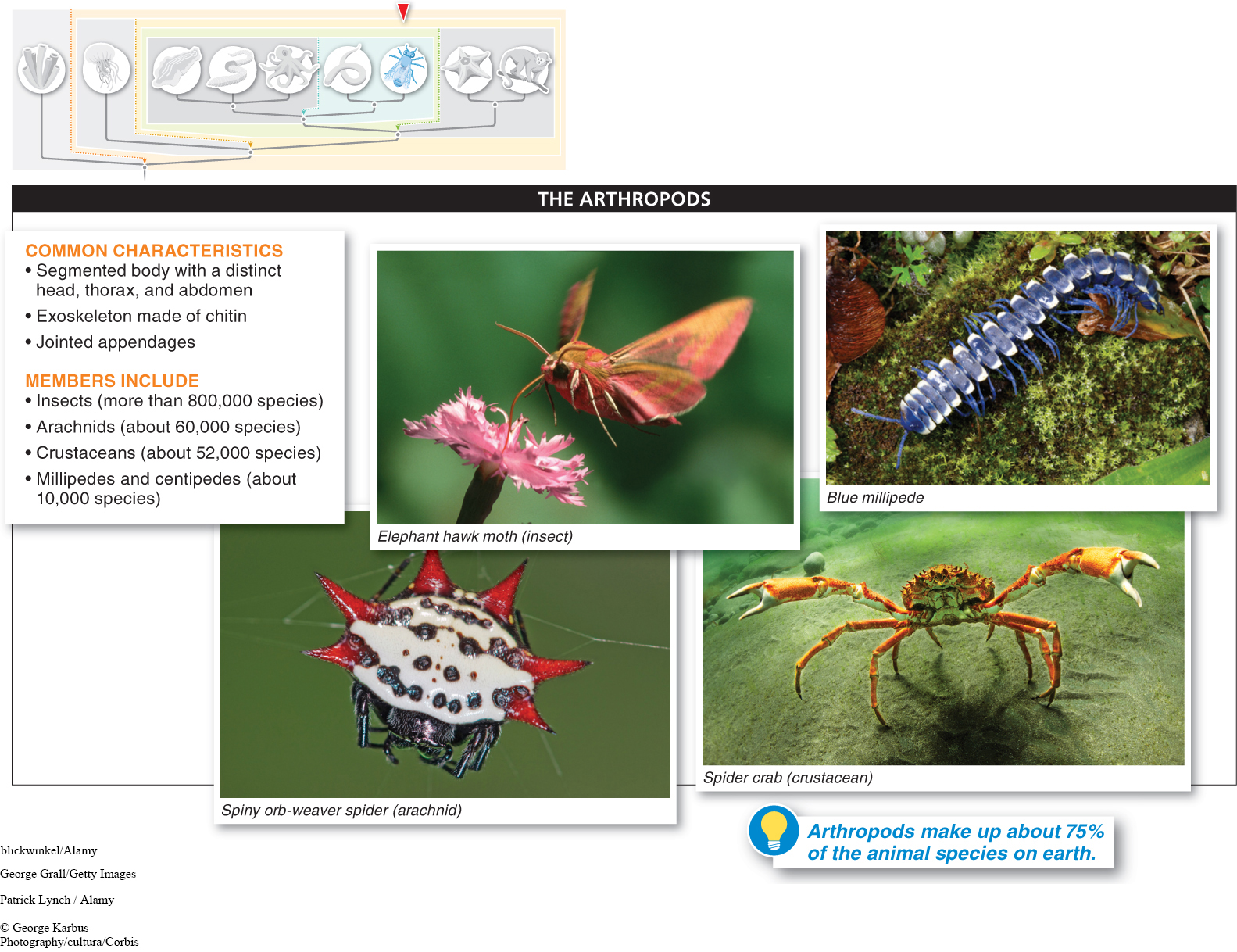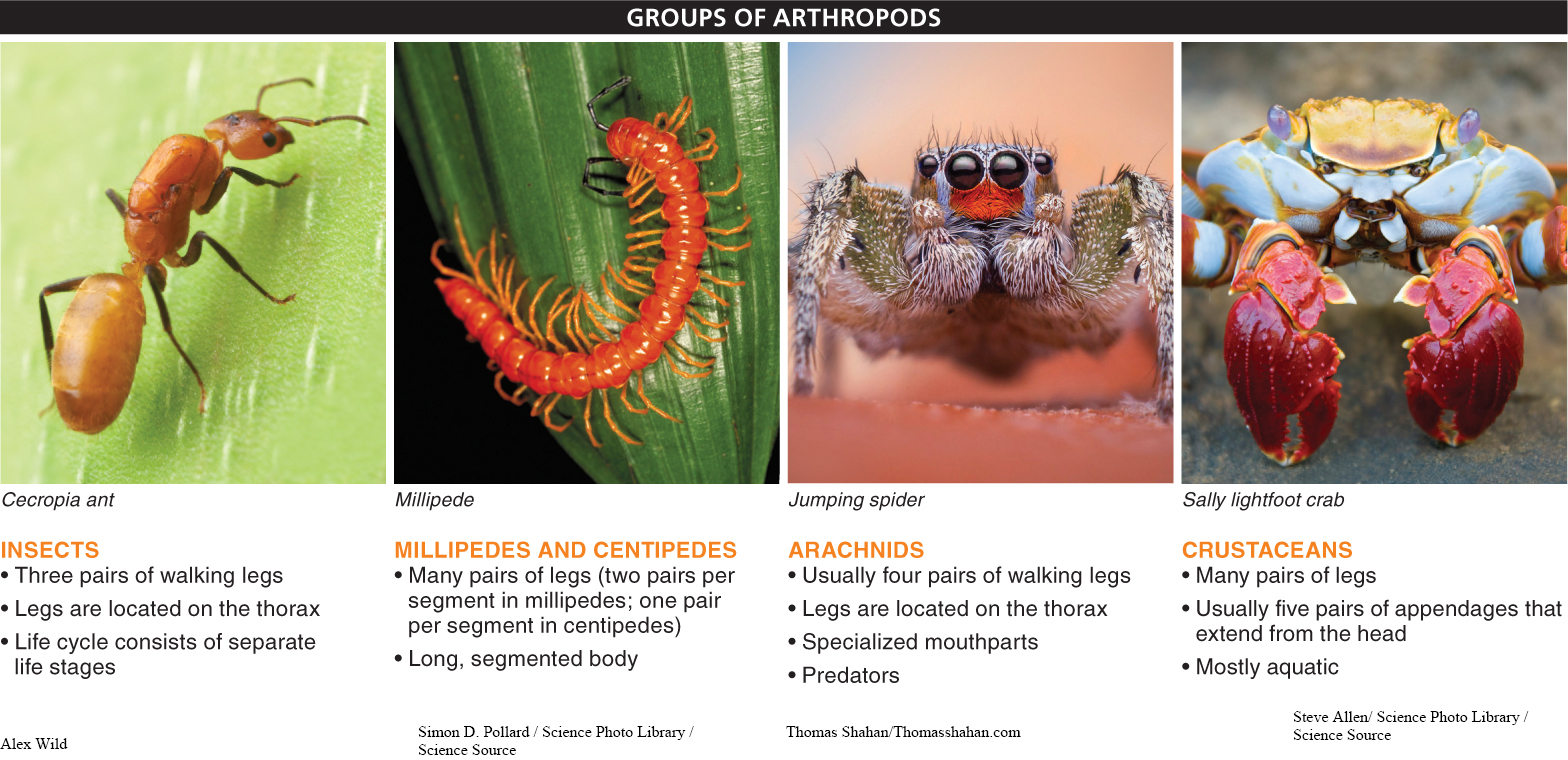11.0.7 11.9: Arthropods are the most diverse group of all animals.
When it comes to species diversity, the arthropods take the cake, outnumbering all other forms of life. In all, the phylum contains almost one million recognized species, or approximately 75% of all animal species and 60% of all species on earth (FIGURE 11-16). Taken together, there are more than a billion billion (1 followed by 18 zeroes) arthropods alive at any given time! And about 80% of these are insects. Put another way, on earth, right now, there are more than 150 million insects for every single human. And there are about six times as many species of beetles as there are species of all birds, mammals, fishes, amphibians, and reptiles combined.

The phylum of arthropods (Arthropoda) contains bilaterally symmetrical, protostome invertebrates that have a distinct head, midsection (called the thorax), and abdomen, a rigid external covering (called an exoskeleton) made of a stiff carbohydrate known as chitin, and legs with joints (think of all the joints in a lobster’s claw) (FIGURE 11-17). The four major lineages of arthropods are:
- Millipedes and centipedes
- Chelicerates (including horseshoe crabs, spiders, mites, ticks, and scorpions)
- Crustaceans (including lobsters, crabs, shrimp, and barnacles)
- Insects

The arthropod phylum is so large that, even if we excluded all the insects—
464
Millipedes and Centipedes The names millipede and centipede translate to “a thousand feet” and “a hundred feet” and refer to the enormous numbers of legs on these long, skinny animals. They don’t really have a thousand—
Chelicerates There are about 60,000 species of chelicerates, a group that includes four horseshoe crab species and the arachnids, land-
Arachnids are predators. Many spiders construct webs by spinning silk fibers (which consist of interconnected protein molecules). Orb-
The venom of most spiders is usually harmless to animals as large as humans, but two North American spiders are dangerous. The black widow spider is easily identified by a red hourglass marking on the bottom surface of the female. The brown recluse spider lacks distinctive markings, so it is harder to identify—
Scorpions look dangerous to humans, but their sting is no worse than a bee’s. Scorpions are lethal to insects, hunting them at night. They seize prey with their claws and use their stinger only if the prey struggles. Some of the scorpion’s mouth structures are covered with spines that grind the prey, while glands secrete enzymes that liquefy it, and the scorpion sucks up the soup.
Crustaceans If arachnids are the most feared arthropods, the aquatic crustaceans—
465
Crustaceans have many pairs of legs, and their legs are modified for many purposes. Shrimp and barnacles (which are closely related to shrimp, but spend their adult lives within a shell, fastened to a rock) have legs with comb-
Although most crustaceans are aquatic, the inconspicuous wood lice (also known as pill bugs, sow bugs, or roly-
Insects Mostly terrestrial, insects have three pairs of walking legs, and most also have one or two pairs of wings extending from the thorax. Insects abound in nearly all terrestrial habitats and are, by far, the most diverse group of arthropods. Every species of plant, for example, is eaten by at least one insect species. Wings and the ability to fly, as well as the developmental process of metamorphosis, have played important roles in the great success and diversification of insects. We explore these features in more detail in Section 11-
TAKE-HOME MESSAGE 11.9
The arthropods are protostome invertebrates, and with nearly one million species (and probably at least as many more yet to be identified), they outnumber all other forms of life in species diversity. Centipedes are predators with fangs that inject venom, and millipedes are herbivores that feed on dead plant material. Spiders and scorpions are predatory arthropods that eat insects and, occasionally, small vertebrates. Lobsters, crabs, shrimp, and barnacles are predatory marine crustaceans. Insects, with adaptations that include the ability to fly and metamorphosis, are the most diverse group of arthropods.
What are the main groups of arthropods besides insects?